Something old, something new: Wisconsin Union Theater gets a makeover while maintaining historic feel
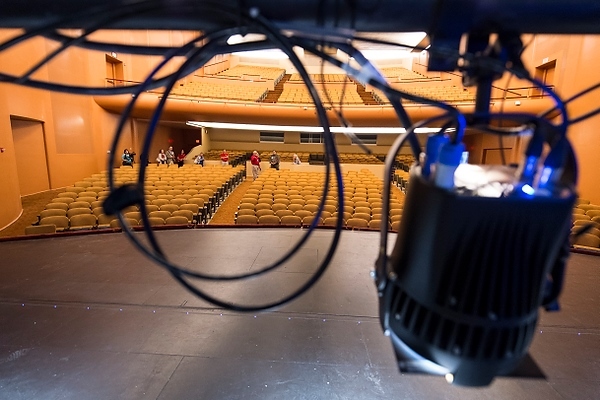
Stage lighting in the process of being installed is pictured in the performance area of the Wisconsin Union Theater’s Shannon Hall during a tour of the newly renovated west wing of the Memorial Union.
Renowned. Renewed. Restored.
Those three words sum up the newly renovated Wisconsin Union Theater. While it won’t host its first official performance until Aug. 22-23 with “Kiss Me Kate,” a sneak peek inside reveals the building itself is quite the showstopper.
“As you walk in, it feels familiar,” says Hank Walter, the theater’s associate director. “And it should.”
The building is a mix of the past and the present — maintaining the character of the old theater while transforming it into a more modern, useful space.
The theater work was part of Phase I of the Memorial Union Reinvestment (MUR), which began in summer 2012 and recently finished. The next portion of the project will begin in fall and is scheduled to be complete in 2016. It will focus on upgrades to mechanical, fire and sprinkler systems. The project marks the first complete renovation of the building since it opened in 1928.
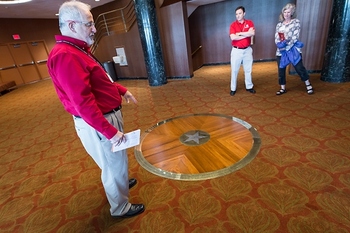
Ralph Russo (left), director of the Wisconsin Union Theater, describes a commemorative star on the lobby floor. The emblem features the names of more than 50 notable people who have performed during the theater’s history.
As visitors walk in to the first floor, they can look through windows down into the Festival Room, which accommodates rehearsals without taking up space on the main stage. It is available to all campus performance groups as well as those working directly with Wisconsin Union Theater.
The building is bright with lots of natural light shining through its hallways, much of which comes through original glass tiles that were preserved.
“It was important to the Wisconsin Historical Society to keep the historic feel,” says Melanie Taylor, Memorial Union Reinvestment project manager for the Boldt Co. and a 2004 UW–Madison engineering graduate.
But keeping the historic feel doesn’t mean the building can’t be made more modern. The west wing was built in 1939, long before the Americans with Disabilies Act, which addresses accessibility. Over the union’s history, it has had 27 different levels.
“One of our main goals was to make this building completely accessible,” Walter says. “We’re thrilled because we want all of our arts patrons to have access to all of our shows.”
The main performance space has been renamed Shannon Hall, thanks to the generosity of the Shannon family who have long supported the university.
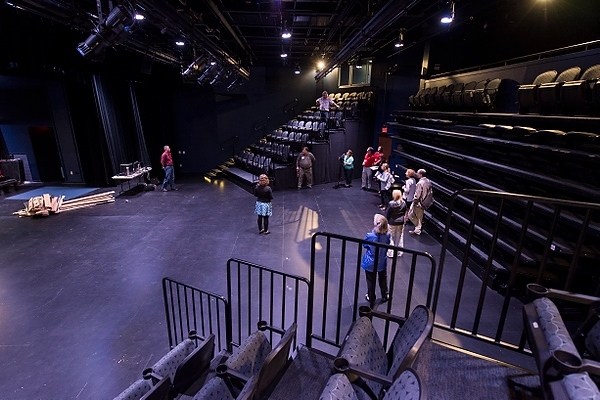
Retractable seating in the performance area of the Fredric March Play Circle.
The original marble and doors were used and paint studies were done to duplicate the original theater color of timeworn terra cotta.
A new HVAC system will keep things more comfortable and quieter.
“It used to take hours to change temperature and you had to get on a six-foot ladder and pull on a chain to move a valve,” says Ralph Russo, the Wisconsin Union’s director of cultural arts and theater. “Sometimes days later you would notice a difference. Now, we can keep things much more comfortable.”
Sound-isolating doors were also added to block out nearby noise. “The acoustics were always good,” Russo says. “Now they’re really good.”
The theater seats are new, increasing from 18 inches wide to a comfier 21 inches. The wood side panels from the original seats were preserved and painted.
The orchestra pit has been expanded to accommodate 30 or more musicians, up from 18 in the past. A fully sprung stage floor has also been added, making it much better for hosting dance companies.
Upcoming performers include Yo-Yo Ma, who will make his seventh appearance at the theater October 18. The upcoming season includes many first-time union performers as well.
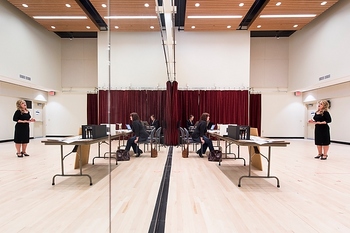
A mirror reflects performers rehearsing in the theater’s Festival Room.
“We want to celebrate our history, but we’re not afraid to look to the future,” Russo says.
The Shannon Sunset Lounge will serve as a lobby during performances and also provides an inviting public space, complete with a glass fireplace and piano just waiting to be played.
And the view. Even on a cloudy, dreary day, it’s good — really good — thanks in part to glass “nano” walls that can completely open onto the union terrace.
Upstairs, the Fredric March Play Circle features state-of-the-art sound and lighting. There is also more backstage and storage space. The retractable, telescopic seating allows the space to be transformed into a cabaret type atmosphere or a more traditional theater. It takes about 20 minutes to prepare the nearly 200 seats — a job that would have previously taken hours with the old chairs.
The neighboring Class of 1925 Gallery has moved to a fully accessible location and is now more able to host a variety of art displayed, hosted and coordinated by the student-led Wisconsin Union Directorate Art Committee.
In the lower level, Wheelhouse Studios melds the former Mini Courses and Craftshop into a “storefront” feel that allows people to get a glimpse at all of the art that is happening. The décor declares, “Art is a verb.”
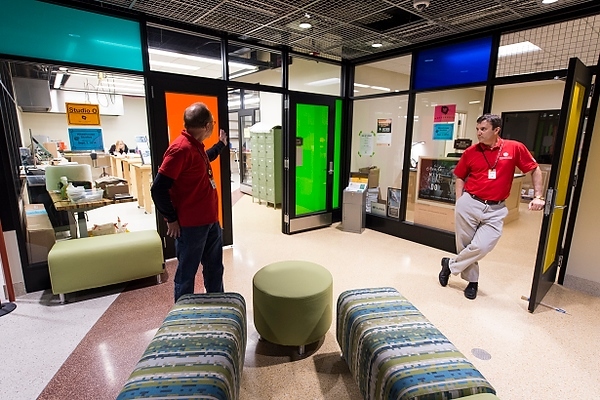
From left, Jay Ekleberry, Wheelhouse Studios director, and Hank Walter, associate director of the Wisconsin Union, describe the new space, which melds the former Union Mini Course and Craftshop programming.
“This is where we do art, not just look at it but engage in it,” says Jay Ekleberry, the Wheelhouse director.
A bulletin board asked people to share their favorite poetry, with lines varying from Lady Gaga to Emily Dickinson to Kanye West to Dylan Thomas.
“I tell people we’re right off of Main Street,” Ekleberry says as he points to the hallway and stairway that leads to Der Stiftskeller. Previously, the craftshop had been tucked away on the fourth floor.
The improvements to Memorial Union are possible thanks to UW–Madison students. In 2006, they approved up to a $96 fee each semester for the next 30 years to fund the Memorial Union renovation and construct a new Union South. The Memorial Union project is also being funded with private donations and union operating funds; the first phase of the renovation will cost $52 million.
It was important to the Wisconsin Historical Society to keep the historic feel. But that doesn’t mean the building can’t be made more modern.
“The student and community involvement allowed us to preserve the building in a way we wouldn’t have otherwise been able to,” Walter says.
More than 17,000 students, faculty, staff, union members and other stakeholders have contributed to the Memorial Union Reinvestment design process by answering surveys and polls, serving in task groups and committees or attending open forums.
The Wisconsin Union Theater is part of the Bascom Hill Historic District and it’s being considered for the National Registrar of Historic Places.
For an alumna like Taylor, it’s been an honor helping modernize this campus icon.
“It’s been amazing to see the revolution of the theater coming back,” Taylor says.
“I think this will open the eyes of the students and the community to see all that the union has to offer.”




